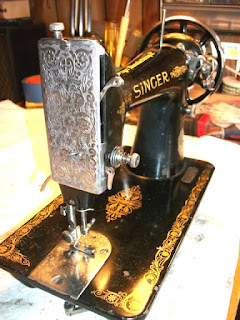There are a couple of vintage machines I have talked about in the past that have a special needle that is almost Impossible to find. If you do happen to find some, they can go for as much as $6.00/each. The Free Westinghouse Rotary and the New Home Rotary are two groups of machines that use these special, short needles. I am basing all of the following information on the
New Home model
NLB rotary sewing machine.
Below is a picture of a needle for the NLB and along with it, a plain, size 14, Schmetz needle that you can buy at your local retailer.
I lined the "EYES" up to show that the shank of the normal, Schmetz needle(bottom) is longer than the New Home(top), CC1221 needle. Now, according to a very knowledgable sewing machine expert named Bill Holman, you can grind the shank down on the Schmetz needle so that the distance from the "shank head" to the top of the eye is the same as the New Home needle.
I have this very convenient, desk top grinder that makes this process very easy.
Here is a picture of the two needles after the grinding process on the Schmetz needle. The "EYES" do line up and the shanks are the same length. The needle point on the Schmetz is a bit longer but that doesn't matter.
When the hook passes the needle on any sewing machine it must be within a proper range from the EYE to be able to pick up the upper thread consistently and at a high rate of speed. If you try this grinding process yourself, please wear the appropriate safety gear. I have tried this process with great success.
Thank you Bill Holman.
This is a picture of a properly timed NLB and a CC1221 needle. Notice the distance of the "Hook Point" above the "EYE". If the needle shank was longer, that "Eye to hook" distance would be greater. Too great a distance to pick up that upper thread consistantly with todays standard needle. There are several different Needle part numbers out there that may or may not work consistently with your machine. If you look back at picture 1 and 4, you will notice that the NLB needle (CC1221) is very close to 1 7/16" in length. There are other needles advertised at this length but the eye is not at the correct location. Here is a 206X13 that is advertised to work.
CC1221 on top and 206X13 on the bottom
The 206X13 needle is about the same length, but it is not a match. The eye is not the same distance from the shank head. It is almost 1/16" too low(pictured). All this information is just my opinion from experience and research. Any additional information is welcome. We should all continue to learn.
















